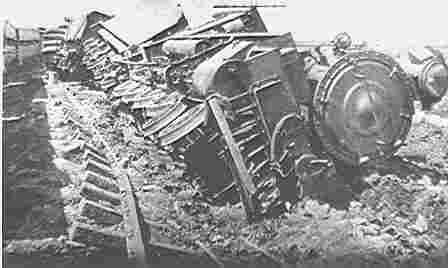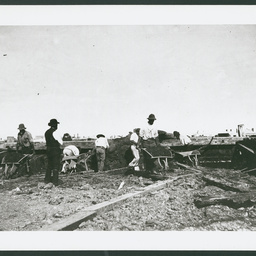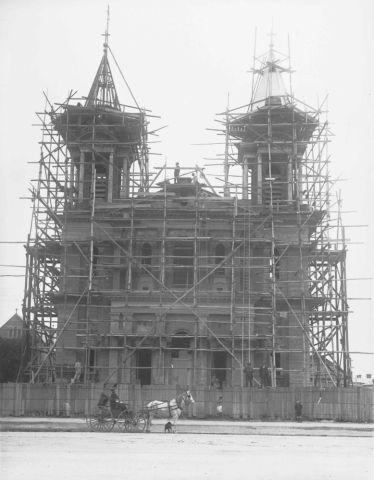As the colony of South Australia was only established in 1836, many projects were undertaken to build up South Australia to attract migrants and colonists alike to the colony. Many of these projects including the building of railways, towns and harbours, which among others elements drew people to the colony. By the end of the nineteenth century, the population of South Australia was an estimated 270’000. These projects fulfilled their purpose in attracting people to the colony. Irish migrants had a very important role in building South Australia, with their participation in many construction projects across South Australia. The Irish played a vital role in the building of South Australia, and aided the establishment of the colony. This brought more people to the region through the work they did in the construction in the colony and in Adelaide.
Railways
The Irish migrants were involved in the building of a railway system in South Australia. Construction on the railways began in 1847, ten years after the foundation of the colony, and whilst this did not have an immediate effect for the colony, it opened a new mode of transport that was not dependent on the sea or horses. There were very few railways built in South Australia to begin with, but it provided work for the Irish labouring force that had already arrived in the colony in its early existence. The Irish had an input in the project, but records indicate that the exact number of Irishmen involved were small in comparison to others groups, but none the less they helped, and in doing this gave the Irish migrants coming to the colony aspirations for work, and in doing so attracted them to South Australia. This in turn helped transportation in the area, allowing more people to travel to the colony.[1]
The Australasian newspaper was the main publication which recorded the ongoing news of the railways and railway construction in South Australia. The newspaper gives many accounts that these railways were vast projects, with railways long as seven hundred miles being constructed. The newspaper unfortunately does not give the reader any detail about the exact number of how many migrants, let alone Irish, were involved in this project.[2] There are not many sources which detail the exact numbers but there are records showing that there were Irish working in South Australia at the time of construction. This would prove to be a useful project for the Irish workers, as they established themselves as able workers on the construction sites, which led to more Irish coming to South Australia to work on the construction of a vastly expanding colony.
Adelaide Harbour
Adelaide presented new work for the incoming Irish migrants. The growing city provided work as the city started to expand, requiring houses and other buildings to be built for the growing population. The original harbour in Adelaide was constructed when the city was founded in 1836, but construction continued on the Adelaide harbour throughout the 1800’s and was a project that the Irish were involved in. There were many projects on the harbour including a reclamation project on the outer harbour. It was a major project which had many people involved with it and the harbour with some minor adjustments and changes over time still stands. The harbour itself serves as an informal memorial for the Irish construction, and again also aided in the transportation to and from South Australia, and in the city of Adelaide. In addition to this, the transportation of migrants to Adelaide was now much more efficient. This allowed for more Irish to travel there thus influencing the Irish involvement in the construction of South Australia.[3]
The Catholic Church
Catholic settlers did have an important role in the shaping of Australia’s colonial landscapes, to which most of these settlers were Irish. The Irish Catholics also played a major role in the building of churches. These churches and places of worship were built in rural areas and in metropolitan areas alike. Churches became the main area for Catholic communities to communicate and interact with each other. This concept of religious ideas and projects bringing people together was further strengthened by communities coming together to raise funds for the building of these churches. This is the epitome of community building. This also helped in the preservation of Irish culture, as these Catholic communities and churches would have been modelled on the Catholic community back in Ireland.[4]
Catholics made up between 10 to 15 percent of the population of Adelaide, most which were of Irish decent. In the late nineteenth century, however, the Catholic church in South Australia expanded, due to a growth in the Irish emigrant population. These new churches were not only built around Irish Catholic traditions and customs, but also constructed by Irish migrants alongside the Australian born Irish Catholics. As the Irish influence grew in the area, the Catholic church helped to preserve the culture of the Irish, as they now had a place where their traditions could be practiced. One of the oldest churches built in Adelaide was Saint Patrick’s Church, which was built and funded by almost the entire Irish community in South Australia. Today Saint Patrick’s Church in Adelaide is still standing and in use, despite a new Saint Patrick’s Church having been built in 1912.[5] It serves as a preservation of Irish culture in Adelaide, and in extension, a celebration of Irish contribution to the construction of Adelaide.[6]
The Irish played a vital role in the construction of South Australia. Although Irish only contributed in small numbers during the founding years of the colony as time went on the Irish population in South Australia grew and played a major role in construction. The railways and the harbour helped South Australia to connect with the rest of Australia much more easily, it also helped the colony to communicate with the rest of the world also. This attracted to larger numbers of migrants to the colony, and in turn led to the Irish establishing their own communities. These Irish communities, in turn set up construction projects through the church, building new towns and communities which helped to preserve Irish culture in South Australia. Overall the Irish Impact in the construction of South Australia was varied, yet they played a vital role in construction none the less, and helped to build the state of South Australia and Adelaide to what it is today.
REFERENCES
[1] ‘Railway Construction in South Australia’ , The Australasian, 19 March 1887, National Library of Australia’s Trove (http://trove.nla.gov.au/newspaper/article/142177947?searchTerm=construction%20in%20Adelaide&searchLimits=)
[2] ‘Railway construction in South Australia’, The Australasian, 19 March 1887, National Library of Australia’s Trove (http://trove.nla.gov.au/newspaper/article/142177947?searchTerm=construction%20in%20Adelaide&searchLimits=)
[3] ‘Adelaide outer harbour bill’, The Mercury, 22 Sept. 1898, National Library of Australia’s Trove (http://trove.nla.gov.au/newspaper/article/9431137?searchTerm=Adelaide%20harbour%20construction&searchLimits=)
[4] L.J. Proudfoot and Diane Hall, Imperial spaces: placing the Irish and the Scots in colonial Australia (Manchester, 2011), pp 225-6.
[5] ‘South Australia: St. Patrick’s new church’, The Catholic Press, 21 Nov. 1912, National Library of Australia’s Trove, (http://trove.nla.gov.au/newspaper/article/106091702)
[6] Proudfoot and Hall, Imperial Spaces, pp 228-9.


